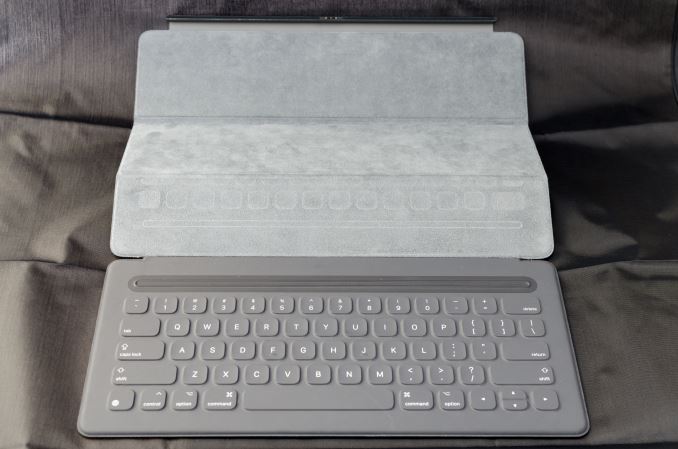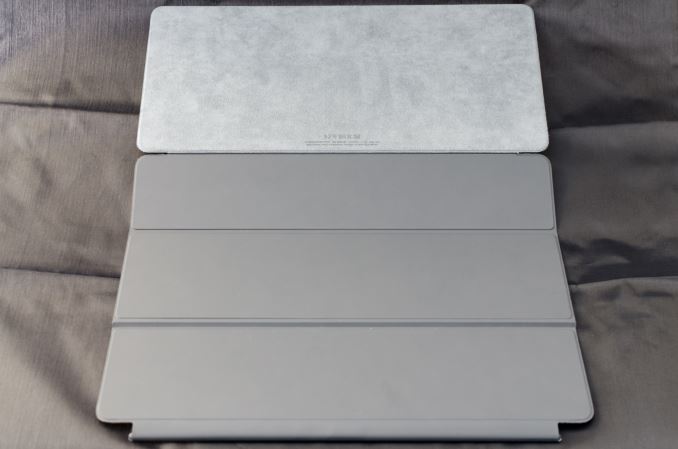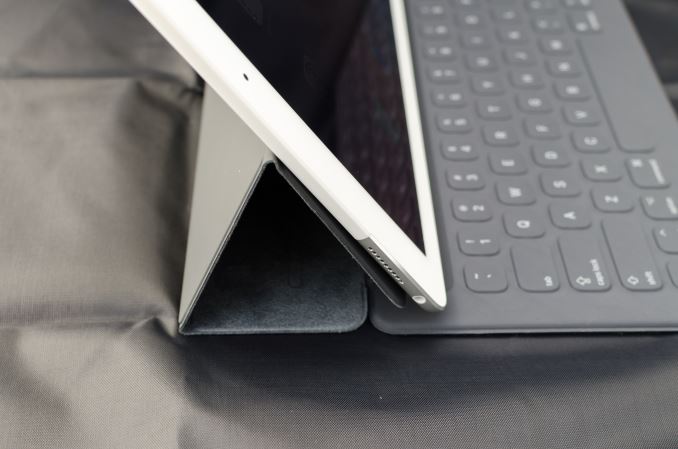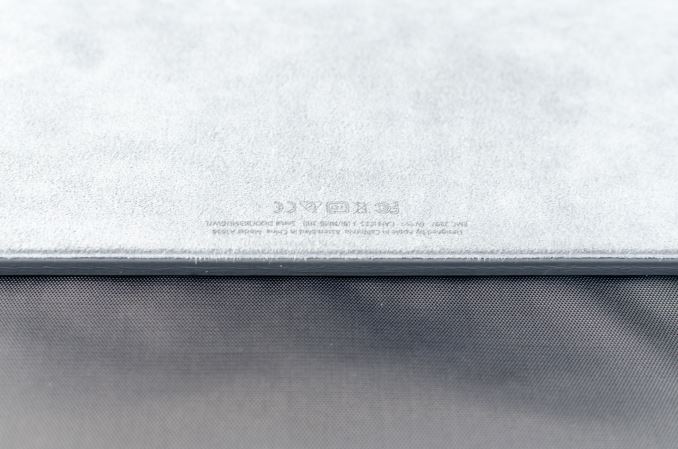The Apple iPad Pro Review
by Ryan Smith, Joshua Ho & Brandon Chester on January 22, 2016 8:10 AM ESTSmart Keyboard
The other half of what makes the iPad Pro worth talking about is the Smart Keyboard. For those that are unfamiliar with how this keyboard works, in essence it’s really a flip cover that happens to hide a keyboard inside of it. This is yet another thing I mentioned that the iPad really needed to improve its potential as a productivity tool.
I’m going to go ahead and spoil this section by saying that while the Smart Keyboard is worthwhile if you’re typing out more than a paragraph, this feels like one of the clunkier aspects of the iPad Pro.
However, the important question is how I got to that conclusion. Going over the user experience of the keyboard is a pretty simple matter. Attaching the cover to the tablet works the same way it always does, which is accomplished by placing the edge of the cover onto the edge of the tablet which also contains the Smart Connector. There are some strong magnets that help with alignment here, and provide the positive pressure needed to ensure that the data and power pins of the Smart Connector are firmly connected to the keyboard.
Once the cover is connected, setting up the keyboard is done by folding it out and doing some origami until the tablet is docked into the right place on the keyboard, which has a noticeable notch to it. Aligning this despite the strong magnets does take some work, as it seems that unless the cover is setup correctly the keyboard isn’t enabled at all.
If you’re trying for precision, I would say that there’s roughly a 4-5 second time delay from the moment that you decide that you need to use the keyboard to actually using it. In addition to this time delay, the keyboard is rather precarious and is basically only stable when you’re using it on a table. While gravity can keep the whole setup somewhat stable on your lap when the display is leaning backwards, if the display starts leaning forwards there’s really nothing stopping it from collapsing and detaching from the cover, as while the magnets are strong enough to hold the tablet in a static state, they aren’t strong enough to hold the tablet if there’s the additional force of decelerating the tablet as it falls. As a result, the angles that the keyboard and tablet can hold relative to each other is fixed.
To be fair, once the keyboard is set up and it’s in a stable position, typing on the tablet is a great experience. The Surface Pro 3 was decent in my experience, but the touchpad with its lack of strong palm rejection made for some frustrating experiences. In this respect, the iPad Pro does a lot better, to the extent that I didn’t have any trouble doing things like typing up long forum posts or various sections of this review. Key travel is short, but there’s good haptic feedback and the layout of the keyboard doesn’t have any strange issues that seem to happen so often to so many tablet keyboards. Something like the Pixel C just doesn’t even compare here, especially because due to the use of Bluetooth it’s absolutely useless in an apartment or any remotely dense environment where the 2.4 GHz spectrum is crowded to the point that it approaches being unusable.
However, despite this significant setup time for the keyboard cover, pretty much the only value for the keyboard cover is text input. Due to the ergonomics of a near-vertical touch screen it’s really not something that can be used for extended periods of time as once you’re done with text input to comfortably use the touch screen you really need to break down the keyboard and revert it back to a simple tablet.
I’ve spent a lot of time thinking about the conundrum of the keyboard when it comes to these tablets, and honestly I don’t think anyone has figured out the right way of doing things yet. I think the Pixel C in form is a step in the right direction, but the execution is unfortunate to say the least. The iPad Pro touchscreen keyboard has the size to allow for touch typing, but the utter lack of position feedback makes it difficult to know where to keep your hands and because touching the display means inputting a character it’s necessary to awkwardly keep your hands right above the glass of the display. The heart of the issue here is that it’s necessary to have an input method where it’s easy to keep your fingers resting on the home row of the keyboard, with clear haptic feedback for input and some indication of where the keys are. It’s also necessary to make sure that this keyboard is easily accessible when it’s needed but quickly stowed away when it isn’t.
I can’t help but wonder whether the better solution here would be something like Lenovo’s Yoga Pro design, but with a different method of execution. Instead of making the two halves a single unit, the keyboard portion should be easily and quickly detached with the smart connector held within the hinge. Rather than a traditional laptop keyboard, something more like the current Smart Keyboard would make a lot of sense. However, I suspect that in doing this a traditional flip cover would no longer make sense as the keyboard would really become an integral part of the user experience once properly integrated. We can talk about how touch-only is a faster and more convenient experience, but this really only applies to navigation as while I can type at about 40 words per minute without issue on a phone or tablet trying to reach 100 words per minute is hard to say the least.
Overall, I should make it clear that the iPad Pro’s Smart Keyboard is not a bad keyboard by any means. When I’m able to just focus on typing, the user experience far exceeds pretty much anything else I’ve tried in the industry. The problem is that as the Smart Keyboard starts to approach the point where I can actually use it, I start to really notice all of the flaws that the implementation has. In this case, the two major issues that really need to be solved here are speed to deploy/stow and lap stability. While a lot has been made of the iPad Pro’s inability to have adjustable viewing angles realistically it only needs two viewing angles, similar to how the Smart Cover only has two viewing angles. If the Smart Keyboard can feel like it appears and disappears almost instantly and can be used without a table effectively, it would probably be the ideal solution to the keyboard problem that tablets face.















408 Comments
View All Comments
Teknobug - Friday, January 22, 2016 - link
This is not a very popular version of the iPad, if it had a mobile version of Mac OS X then yeah there'd be a reason to use one but otherwise it's just a larger iPad. Seems the iPad mini is growing in demand. During the Christmas shopping season at the Apple store near me, the wall where the iPad Pro was often empty, most of the crowd were around iPad minis and MacBooks and occasionally checking out the next gen Apple TV with the infrared remote.blackcrayon - Friday, January 22, 2016 - link
The popularity of any iPad or most computing devices in general is going to come down to cost...Funny, compare your logic on "reason to use" an iPad pro with what was said about the original iPad. "It's just a 'Big EyeTouch, there's no reason to use it!".
KPOM - Friday, January 22, 2016 - link
Supposedly 12% of the iPads sold last quarter were the Pro (at least according to one of those retail surveys that always come out around earnings time). Considering that it starts at $799 and goes all the way up to $1347 with all the bells and whistles, that's pretty good.cknobman - Friday, January 22, 2016 - link
Its really hard to take your reviews seriously when the entire tone is "how to spin this as good"."We need to make it sound like its worth $1000 for a iPad or we wont get anymore Apple crap to review".
It is comical to hear you try and excuse the keyboard and even slant the argument to say its a better idea than its counterparts like the Surface Pro. COMICAL, that keyboard implementation on the iPad Pro in its current form is a POS.
You make BS statements like the "The Surface Pro 4 comes close to be sure, but I would argue that it really isn’t a proper tablet by virtue of how dependent it is on trackpad input."
Surface Pro is completely and perfectly capable and independent of needing a trackpad for input when using it as a tablet.
Sure when you run desktop applications it becomes incredibly dependent on a trackpad but its BECAUSE ITS RUNNING A DESKTOP APPLICATION!
iPad Pro is a cool concept and has potential but its just a bigger iPad still running the same OS as the freaking PHONES!!!
In no way is it even close to being worth the cost until they put a more functional operation system on it.
Kevin G - Friday, January 22, 2016 - link
That is the thing. Most of the pro stuff you'd want to run on a Surface is a desktop application. Using the track pad here makes sense given the application though it does go against the idea of a touch based tablet.Apple on the other hand has one OS designed around touch input and another around keyboard/mouse. The downside here is that applications can appear on one OS and not the other. That is the problem Apple has with the 'pro' moniker here is that there are few truly professional level applications available. Given the history of Apple's app store, I would not expect this to remain true for long.
So essentially MS and Apple have chosen different paths for tablets and considering the trade offs with each product, I think it is safe to say that both companies have not found the perfect mix. For the end user, do a bit of research and simply pick the best tool for the job.
iwod - Friday, January 22, 2016 - link
This, it is funny they accused Anandtech when they don't even understand the difference.cknobman - Friday, January 22, 2016 - link
It is even funnier when you assume to know anything about someone, just makes you look ignorant.I'm a software developer who writes software for corporations, personal use, and public use.
I have published applications for web, desktop, and mobile applications.
I understand, probably more than you could comprehend, the differences between platforms and what the purpose, use cases, and requirements are for each.
iwod - Saturday, January 23, 2016 - link
No, I don't need to know anything about you. You have already make your point across, and it is rather obvious you are on the Microsoft camp. Nothing wrong with that.But there is a fundamental difference between the two camp, Microsoft and Apple view of Computing platform. One doesn't make the other one any better. Read a few post post below yours. And being a decent software developer doesn't make you any difference or better then anyone on UX or platform.
name99 - Friday, January 22, 2016 - link
Nice try, Kevin, but stupidity is a constant in the world.I've been trying to explain this point (Apple has two UI's on top of one OS), along with related issues like how Apple doesn't sell all-in-one devices because they use iCloud to glue different devices together, for years.
But if your entire world view depends on being unreasonable, then unreasonable you will be... It's not enough to accept that Apple has a different analysis of how to do computing than MS; it has to be stated repeatedly that "APPLE'S VIEW IS GARBAGE, WRONG, STUPID, IDIOTIC, DOOMED TO FAIL!!!"
SFoster4 - Friday, January 22, 2016 - link
"APPLE'S VIEW IS GARBAGE, WRONG, STUPID, IDIOTIC, DOOMED TO FAIL!!!" Really? Considering Apple can buy a number of countries out there you might want to rethink that statement. God I get sick of jealous people who have nothing better to do than rail on about Apple. Get a life.